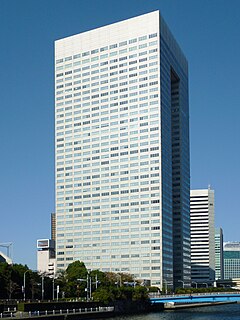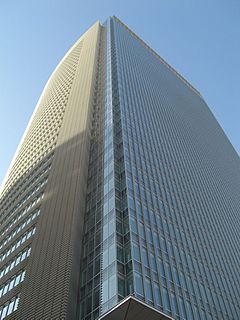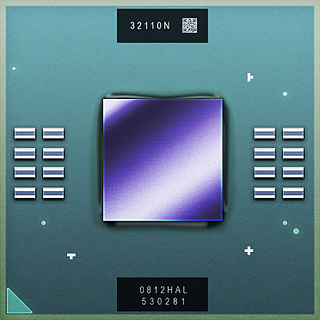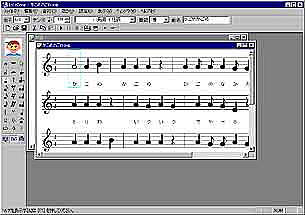Related Research Articles

Fujitsu Limited is a Japanese multinational information and communications technology equipment and services corporation, established in 1935 and headquartered in Tokyo. Fujitsu is the world's sixth-largest IT services provider by annual revenue, and the largest in Japan, in 2021. The hardware offerings from Fujitsu are mainly of personal and enterprise computing products, including x86, SPARC and mainframe compatible server products, although the corporation and its subsidiaries also offer a diversity of products and services in the areas of data storage, telecommunications, advanced microelectronics, and air conditioning. It has approximately 126,400 employees and its products and services are available in approximately 180 countries.

Toshiba Corporation, commonly known as Toshiba and stylized as TOSHIBA, is a Japanese multinational conglomerate corporation headquartered in Minato, Tokyo, Japan. Its diversified products and services include power, industrial and social infrastructure systems, elevators and escalators, electronic components, semiconductors, hard disk drives (HDD), printers, batteries, lighting, as well as IT solutions such as quantum cryptography which has been in development at Cambridge Research Laboratory, Toshiba Europe, located in the United Kingdom, now being commercialised. It was one of the biggest manufacturers of personal computers, consumer electronics, home appliances, and medical equipment. As a semiconductor company and the inventor of flash memory, Toshiba had been one of the top 10 in the chip industry until its flash memory unit was spun off as Toshiba Memory, later Kioxia, in the late 2010s.

MSX is a standardized home computer architecture, announced by Microsoft and ASCII Corporation on June 16, 1983. It was initially conceived by Microsoft as a product for the Eastern sector, and jointly marketed by Kazuhiko Nishi, then vice-president at Microsoft and director at ASCII Corporation. Microsoft and Nishi conceived the project as an attempt to create unified standards among various home computing system manufacturers of the period, in the same fashion as the VHS standard for home video tape machines.

A rice cooker or rice steamer is an automated kitchen appliance designed to boil or steam rice. It consists of a heat source, a cooking bowl, and a thermostat. The thermostat measures the temperature of the cooking bowl and controls the heat. Complex, high-tech rice cookers may have more sensors and other components, and may be multipurpose.
1983 has seen many sequels and prequels in video games, such as Mario Bros. and Pole Position II, along with new titles such as Astron Belt, Champion Baseball, Dragon's Lair, Elevator Action, Spy Hunter and Track & Field. Major events include the video game crash of 1983 in North America, and the third generation of video game consoles beginning with the launch of Nintendo's Family Computer (Famicom) and Sega's SG-1000 in Japan. The year's highest-grossing video game was Namco's arcade game Pole Position, while the year's best-selling home system was Nintendo's Game & Watch for the third time since 1980.

The Libretto is a line of subnotebook computers that was designed and produced by Toshiba. The line was distinguished by its combination of functionality and small size, squeezing a full Windows PC into a device the size of a paperback book. The first Libretto model, the Libretto 20, was released on April 17, 1996, with a volume of 821 cm3 (50.1 cu in) and weighing just 840 g (30 oz), making it by far, the world's smallest commercially available Windows PC at the time, and a trend the Libretto Range continued for many years. The original Libretto line was discontinued in Europe and the U.S. in 1999, but the production continued in Japan with the SS, FF and then the L series until 2002. The first L series Libretto was released on 18 May 2001 and the last just 11 Months later on 24 April 2002. Production of all Librettos ceased from 2002 until the release of the Libretto U100 in 2005.

EMI Music Japan Inc., formerly Toshiba EMI, was one of Japan's leading music companies. It became a wholly owned subsidiary of British music company EMI Group Ltd. on June 30, 2007, after Toshiba sold off its previous 45% stake. Its CEO and president was Kazuhiko Koike. When EMI Music Japan was trading as Toshiba-EMI, it was involved with the production of anime. On April 1, 2013, the company became defunct, following its absorption into Universal Music Japan as a sublabel under the name EMI Records Japan.
The transistor count is the number of transistors in an electronic device. It is the most common measure of IC complexity. The rate at which MOS transistor counts have increased generally follows Moore's law, which observed that the transistor count doubles approximately every two years.

SpursEngine is a microprocessor from Toshiba built as a media oriented coprocessor, designed for 3D- and video processing in consumer electronics such as set-top boxes and computers. The SpursEngine processor is also known as the Quad Core HD processor. Announced 20 September 2007.
These tables provide a comparison of netbooks.
Sord Computer Corporation is a Japanese electronics company, founded in 1970 by the entrepreneur Takayoshi Shiina.

T3100 is a portable PC manufactured by Toshiba released in 1986. It features a 10 MB hard drive, 8 MHz Intel 80286 CPU and a black & orange 9.6" gas-plasma display with a resolution of 640x400 pixels.

Toshiba Pasopia 7 is a computer from manufacturer Toshiba, released in 1983 and only available in Japan. It was intended as the successor of the Toshiba Pasopia, offering improved sound and graphics. Graphic memory is increased to 48 KB and two SN76489 sound chips are available, producing six five-octave channels and two noise channels.

LaLaVoice (ララボイス) is a vocal synthesizer designed for the Japanese language.

The Toshiba T1000LE was a Toshiba laptop made in 1990 as a member of their LE/SE/XE family. It used a 9.54/4.77 MHz Intel 80C86, with the clock speed being switchable by using function keys on the keyboard. The laptop came with a 20 MB hard drive, 1 MB of RAM, a 1.44M/720K switchable 3.5" floppy drive, and a blue-on-white, back-lit, "Toshiba Graphics" 640x400 STN LCD. The laptop came with a choice of either MS-DOS 3.3 or 4.01 stored in a socketed ROM. The laptop's RAM was expandable to 2 MB, 3 MB, 5 MB, or 9 MB with 1 MB, 2 MB, 4 MB, and 8 MB proprietary memory cards, respectively.
Dynabook Inc., formerly Toshiba Client Solutions Co., Ltd., is a Japanese personal computer manufacturer owned by Sharp Corporation; it was owned by, and branded as, Toshiba from 1958 to 2018. It claims its Toshiba T1100, launched as 1985, as the first mass-market laptop PC. Toshiba had used the brand name "DynaBook" or "dynabook" since 1989, but Dynabook became the worldwide brand in 2019.

Toshiba Pasopia is a computer from manufacturer Toshiba, released in 1981 and based around a Zilog Z80 microprocessor. This is not to be confused with the Toshiba Pasopia IQ, a similar named line of MSX compatible computers.
Toshiba Pasopia 16 or PA7020 is an IBM PC compatible computer from manufacturer Toshiba, released in 1982 and based around a Intel 8088-2 microprocessor running at 6 MHz. It's also known as T300 on the US and PAP in Europe.

The Toshiba Pasopia IQ are a series of MSX compatible machines released by Toshiba between 1983 and 1985. This is not to be confused with a different computer line with the similar name of Toshiba Pasopia.
References
- 1 2 "東芝パーソナルコンピュータ PASOPIA5" [Toshiba personal computer PASOPIA5 (PA7005)]. cms.matrix.jp (in Japanese). kps@web.design.co.jp. Retrieved 2021-11-29.
- ↑ "Toshiba Pasopia 5". www.system-cfg.com. Retrieved 2021-11-30.
- ↑ "1000 BiT - Computer's description". www.1000bit.it. Retrieved 2021-11-30.